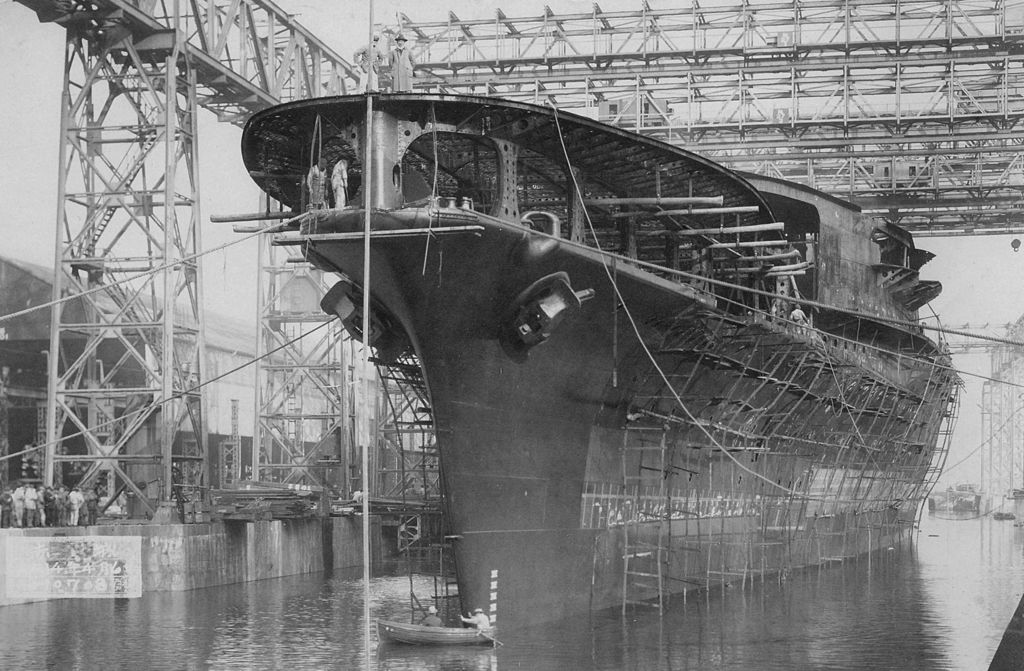The Japanese had planned, with their 8x8 building program, to be one of the three major naval powers of the world. The Washington Treaty cut the Japanese back to what they considered as a second rate naval power. Whether they knew it or not, the Washington Treaty saved the Japanese expending billions of yen on what would have shortly been obsolete warships. The two classes laid down first in the 8x8 series were the four Amagi Class battlecruisers and the four Tosa class battleships. The Japanese were still building separate types where the rest of the world were going for "Fast Battleships" in their new designs. The next two ships laid down were the first pair of the Kii class fast battleships.

Magnificent ships, they had a blend of speed, armour, and armament their predecessors only had two/thirds of. Washington swung his mighty axe and eight of the ten ships needed to be scrapped. This would cost the Japanese millions of yen they had already invested in the eight ships to be scrapped. What saved the last two hulls from the scrapyard, was the proviso in the Treaty that two hulls could be converted to ships to operate fixed wheel aircraft (termed aircraft carriers, CV designation). The Japanese originally chose the two Amagi class battlecruisers as they had had the most work done on them and would be closest to completion. Shortly after this decision, both of the ships were damaged in an earthquake. The Japanese Navy decided that all of the original eight ships would be scrapped, and they would use the two Kii class ships to build the new aircraft carriers from.

Swapping to the Kii hulls meant that completion went from 1925 out to 1927. Armament ideas changed from one design to the next. The Washington treaty allowed aircraft carriers to carry up to 8" guns. The Japanese Navy designers were told one day to fit 8" guns, the next 5.5" then only 4.7" AA. The Navy was not certain as to what would be the ships major opponent. Cruisers would require 8" guns on the carriers to keep them at bay. Destroyers and their torpedoes would need 5.5" guns to fend them off and keep them out of torpedo range. If a battleship, battlecruiser, came within range then they would be toast. The simplest method was to leave the 5.5" gun deck in place from the original battleship design and accept that anything bigger than destroyers would have to be handled by the ships escorts. A set of six, 4.7" AA guns, was fitted for barrage work, while eight 13.2mm machine guns would do the close in AA work. The original 12" armoured belt was removed and replaced with a 4.7" one. This matched the 4.7" deck armour and gave a useful set of armour protection.
The triple take off area at the bow was a problem from day one. It looked excellent on paper, launch three aircraft at a time, but in practice the middle launching deck was too short for aircraft with any sort of load. The three decks had to be in constant communication so that mid-air collisions could be avoided during takeoff. Which leads on to command and control functions. A bridge structure was trialed on the Hosho, but on the advice of senior aircrew, was removed. The British had both in the Furious/Glorious types and fitted a bridge to the Furious as they had proved that putting your command functions in one place was superior to having them spread out. While the Japanese may have been annoyed with the British and U.S., up till 1930 they would be granted access to non-secret things. Whether a bridge superstructure worked on a carrier or not would certainly be information that would be shared. The three years from completion till 1930 would certainly have been enough time to find out about whether the three deck take off system worked or not. It didn't, so it came down to when would the system have been replaced and a full hangar and flight deck be installed. My feeling would be that the changes would have had to be made before the 'Kate' bomber came into service as it would need all the help it could get. The refits would be completed late 1937.

The massive 1936-37 refit was undertaken to right many of the wrongs that the first 10 years of aircraft operations had shown needed to be fixed. The major work to be done was, fix the triple deck by removing it and replacing it with hangar space. The Japanese had taken note of the Hermes and the US Lexington with their enclosed bows, and would fit the same to the Kii and Owari. The 5.5" guns were taken out and the gun deck plated over and turned into more accommodation spaces. The new command center and bridge superstructure would be fitted forward of the funnel, but the funnel arrangement would be left the same. The aft hangar areas would also be extended. The single 4.7" would be removed and replaced with twin 5" AA guns. The first 25mm would be fitted in twin and single mountings. These weapons would increase in numbers until both ships had been sunk. This is the main version that would fight the early battles of the Second World War.
Now I remember why I am not that fond of overhead drawings. That 1939 post rebuilding drawing took ages. Still not sure if I lined everything up properly. Went cross-eyed trying to check.
